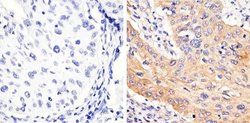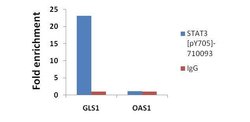Learn More
Invitrogen™ Phospho-STAT3 (Tyr705) Recombinant Superclonal™ Antibody (3HCLC)
Rabbit Recombinant Superclonal Antibody
Supplier: Invitrogen™ 710093
Description
This antibody is predicted to react with mouse, rat and non-human primate based on sequence homology. Recombinant rabbit Superclonal™ antibodies are unique offerings from Thermo Fisher Scientific. They are comprised of a selection of multiple different recombinant monoclonal antibodies, providing the best of both worlds - the sensitivity of polyclonal antibodies with the specificity of monoclonal antibodies - all delivered with the consistency only found in a recombinant antibody. While functionally the same as a polyclonal antibody - recognizing multiple epitope sites on the target and producing higher detection sensitivity for low abundance targets - a recombinant rabbit Superclonal™ antibody has a known mixture of light and heavy chains. The exact population can be produced in every lot, circumventing the biological variability typically associated with polyclonal antibody production. Note: Formerly called Recombinant polyclonal antibody, this product is now rebranded as Recombinant Superclonal™ antibody. The physical product and the performance remain unchanged.
STAT3 belongs to the family of STAT (signal transducers and activators of transcription) proteins which are phosphorylated by receptor associated kinases, translocate to the nucleus, and act as transcription factors in response to cytokines and growth factors. Coactivators such as CREB-binding protein are required for the transcriptional activation by STAT3. STAT3 can also be activated by Interferon-alpha, Interferon-gamma, EGF, PDGF and IL6. Phosphorylation on tyrosine 705 by JAK1 and JAK2 is essential for STAT3 dimer formation, nuclear translocation, and DNA binding activity. In humans, the STAT3 gene is located on the q arm of chromosome 17. STAT3 has been shown to be activated by IFN-alpha but not IFN-beta. The transcription factors associated with STAT3 are c-Jun and cyclic AMP-responsive enhancer binding protein (CREB). STAT3 mediates the expression of a variety of genes in response to cell stimuli, and thus plays a key role in many cellular processes such as cell growth and apoptosis. The small GTPase Rac1 has been shown to bind and regulate the activity of STAT3 while the PIAS3 protein is a specific inhibitor of STAT3. Three alternatively spliced transcript variants encoding distinct isoforms of STAT3 have been described. Deletion of the STAT3 gene in knock-out mice was lethal at the early embryonic stage.
Specifications
| Phospho-STAT3 (Tyr705) | |
| Recombinant Superclonal | |
| 0.5 mg/mL | |
| PBS with 0.09% sodium azide | |
| P40763 | |
| STAT3 | |
| Peptide corresponding to amino acids 698-709 of human STAT3. | |
| 100 μg | |
| Primary | |
| Human | |
| Antibody | |
| IgG |
| ChIP Assay, Immunohistochemistry (Paraffin), Western Blot | |
| 3HCLC | |
| Unconjugated | |
| STAT3 | |
| 1110034C02Rik; acute phase response factor; acute-phase response factor; ADMIO; ADMIO1; APRF; AW109958; DNA-binding protein APRF; FLJ20882; HIES; MGC16063; signal transducer and activator of transcription 3; signal transducer and activator of transcription 3 (acute-phase response factor); signal transducer; activator of transcription; acute-phase response factor; signal transduction and activation of transcription 3; STAT; STAT3; STAT-3; stat3 protein; STAT3b1; STAT3b2; transcription factor; Unknown (protein for MGC:128731); wu:fc15d02; wu:fl59g06; z-Stat3 | |
| Rabbit | |
| Protein A | |
| RUO | |
| 6774 | |
| Store at 4°C short term. For long term storage, store at -20°C, avoiding freeze/thaw cycles. | |
| Liquid |
Your input is important to us. Please complete this form to provide feedback related to the content on this product.



